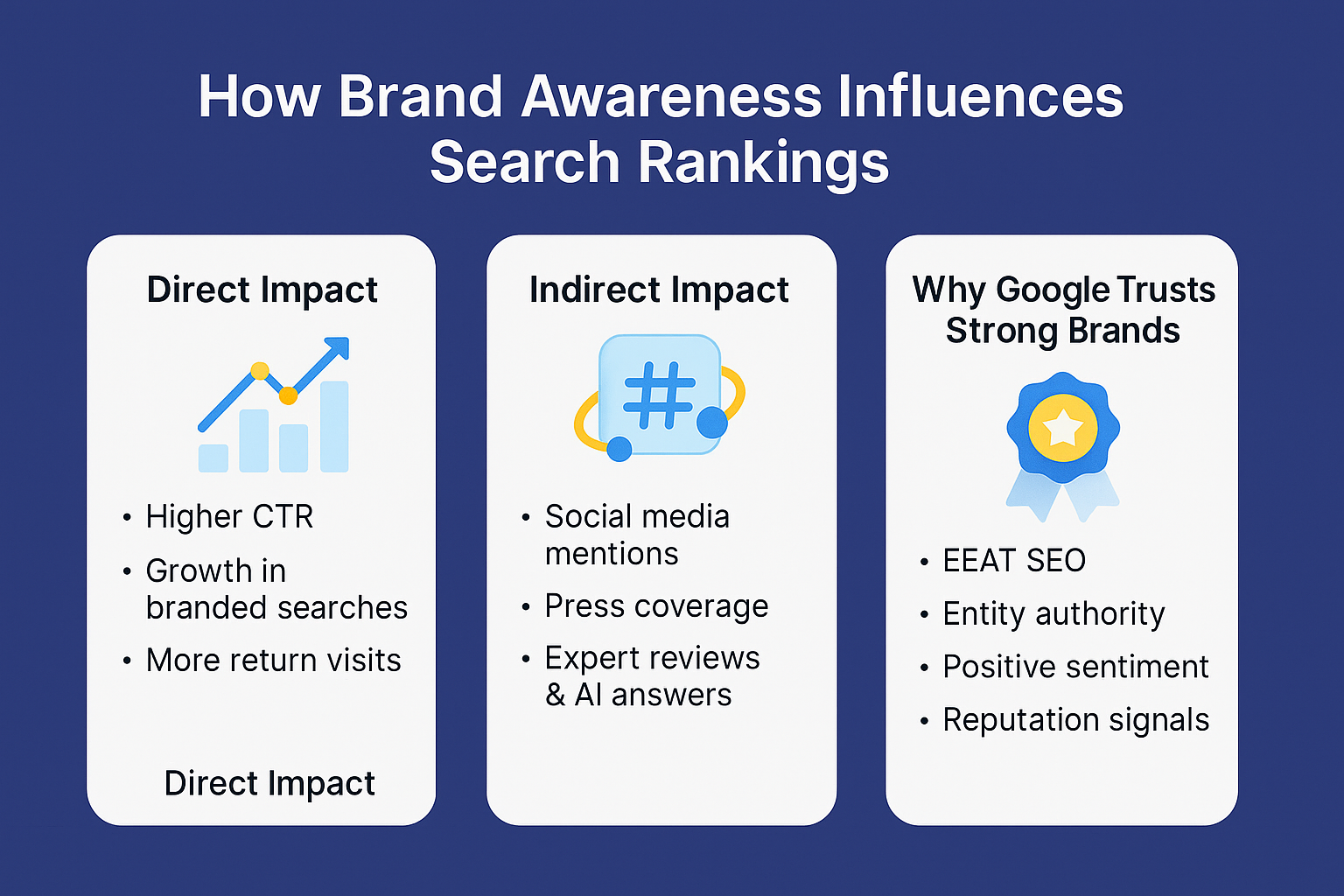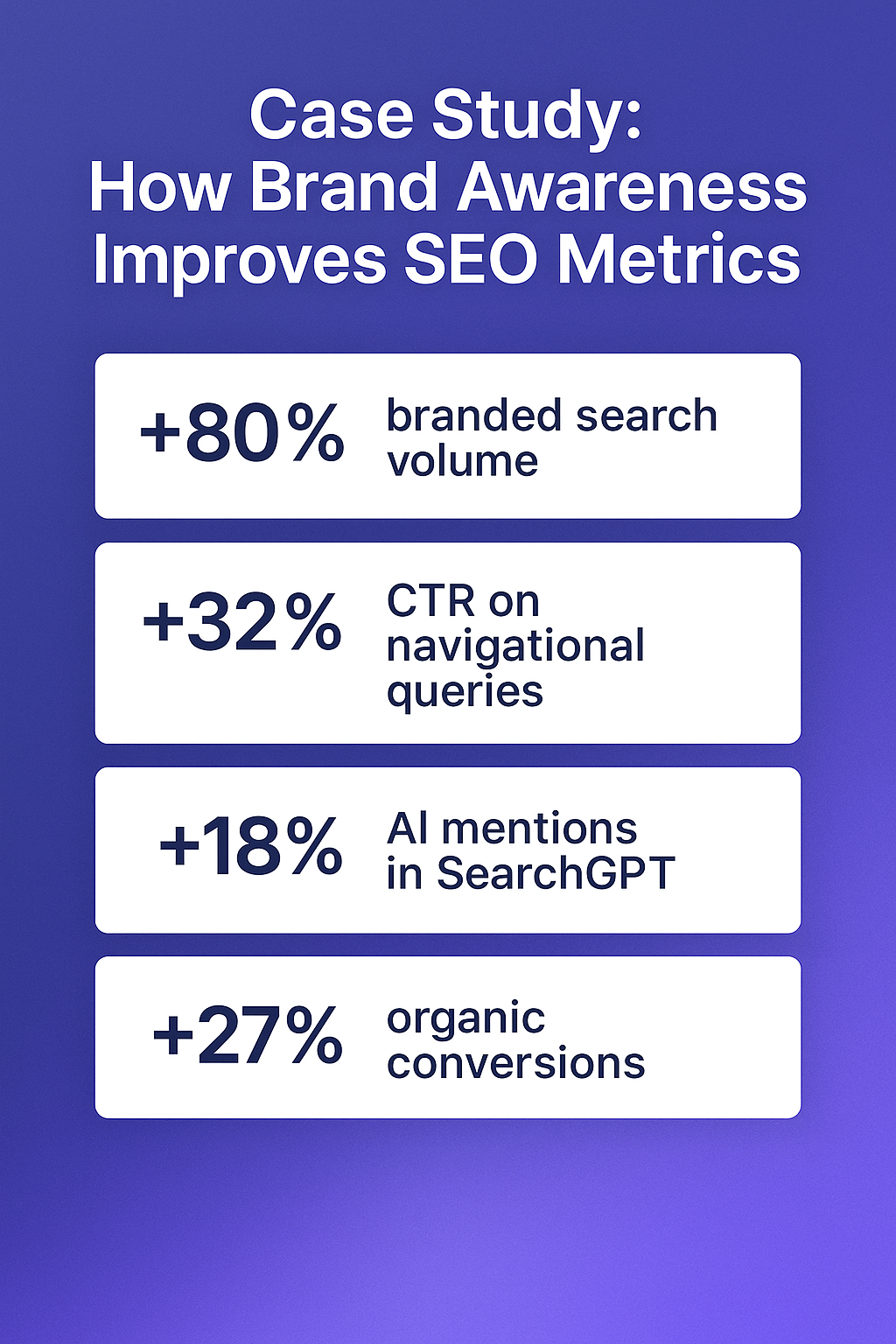November 21, 2025
Semantic Blocks: The New Structure of AI-Optimized Content
November 20, 2025
Multimodal SEO: How AI Uses Images, Video & Diagrams to Rank Pages
November 19, 2025
Author:
.png)
Brand awareness has become one of the most influential — and underrated — factors in modern SEO. When users recognize, trust, and actively search for a brand, it creates a measurable impact across every search metric: higher CTR, stronger engagement, more branded queries, and a clear signal of credibility. In other words, brand visibility directly translates into better search visibility.
Search engines increasingly rely on brand signals to understand which websites deserve priority. Google, Bing, and AI-driven platforms like SearchGPT or Perplexity use patterns such as branded searches, unlinked mentions, consistent entity information, and sentiment to evaluate authority. If a brand is frequently referenced across the web — even without links — it is seen as more trustworthy and more relevant.
In 2025, SEO is no longer just about keywords — it’s about the strength of your brand as a ranking signal.
As search evolves into an AI-driven ecosystem, brands that invest in awareness, reputation, and semantic consistency will outperform those relying solely on technical or content tactics.
Brand awareness has a measurable impact on search performance because it strengthens both direct and indirect ranking signals. When users recognize and trust a brand, they interact with it differently — and search engines pick up on those patterns immediately.
Strong brand awareness improves several core behavioral signals:
These direct interactions help establish brand authority, which plays a major role in competitive niches where many pages have similar intent and content quality.
Brand-driven visibility also creates broader ecosystem signals that search algorithms monitor closely:
Even unlinked mentions now contribute to overall authority, because Google increasingly understands reputation beyond hyperlinks.
Google’s shift toward EEAT SEO (Experience, Expertise, Authoritativeness, Trustworthiness) places brand strength at the center of ranking evaluation.
A strong brand typically has:
Search engines want to show reliable sources — and reliable sources tend to be recognizable brands.
As a result, improving brand visibility is no longer a marketing goal alone — it is a powerful SEO strategy that determines long-term rankings and trust.

Brand-driven ranking factors have become far more important in the AI search era. Google and next-gen engines evaluate how often a brand is searched, mentioned, and trusted — even outside traditional backlinks. These brand signals help algorithms understand whether the business is a real, reputable entity.
A steady rise in branded searches is one of the strongest trust indicators.
If more people search for a brand directly, algorithms interpret this as market validation — a sign that the brand has authority and established demand.
Google now processes unlinked mentions almost as deeply as traditional backlinks.
Every time a brand is referenced on a blog, in news, in social posts, or in a forum thread, it contributes to reputation and relevance — even without a clickable URL.
Search engines expect the brand to appear as one unified entity across the web.
Consistent name, description, NAP data, and profiles strengthen the entity graph, making it easier for algorithms to trust the brand and connect it with the correct topics.
Modern search engines often list brand names inside answers generated by SearchGPT, Bing Copilot, and Perplexity.
Being cited or recommended by these models has become a new form of AI search visibility, proving that the brand is recognized as a trusted source.
User-generated content, reviews, ratings, social discussions, and influencer mentions all reinforce brand credibility.
High-sentiment social proof increases both user trust and algorithmic trust.
In 2025, these signals collectively determine whether a brand qualifies as an authoritative entity — and therefore how well it ranks.
Growing brand awareness isn’t guesswork — it’s a structured, multi-channel strategy that supports both visibility and search rankings. Below is a practical framework that companies use in 2025 to strengthen brand presence and SEO simultaneously.
Publish high-authority content that positions the brand as an expert:
This content fuels organic search, supports EEAT, and increases branded search demand over time.
PR still drives some of the strongest brand awareness results:
These PR activities generate reputation signals and increase unlinked mentions.
Short-form content builds reach and visibility much faster than traditional SEO:
To appear inside AI answers, brands must supply structured, machine-readable information:
Strong awareness also grows through real user communities:
Community engagement increases brand visibility organically and creates long-term credibility.

To understand how brand awareness translates into measurable SEO performance, let’s look at a real scenario reflecting results achievable in 2025. These numbers can represent the impact seen in projects like SpotRise, Dating.com, or any brand actively investing in long-term brand visibility.
Over a 4-month period, after implementing a combined brand and SEO strategy, the results were significant:
This SEO case study demonstrates a clear pattern: when brand growth becomes part of your SEO strategy, every metric—CTR, conversions, impressions, authority—accelerates together.
Brand awareness doesn’t just support SEO. It multiplies its impact.

Most brands underestimate how interconnected brand visibility and SEO really are. These mistakes limit ranking potential even for technically strong websites.
Social platforms matter, but brand growth SEO requires a holistic presence across PR, communities, AI search, and authoritative content—not just viral posts.
Traffic alone doesn’t tell the full story.
Unlinked mentions, community discussions, and expert references matter just as much for entity building.
Different names, mismatched descriptions, conflicting NAP data—these create entity SEO issues and weaken trust signals.
Search engines expect one clean, unified identity.
Brands still overlook Perplexity, SearchGPT, and Bing Copilot—despite these platforms shaping modern discovery.
If your brand isn’t present in AI-generated results, your visibility is incomplete.
Avoiding these brand awareness mistakes keeps your entity strong and prevents search engines from misinterpreting or undervaluing your brand.
Search is evolving from indexing pages to understanding entities.
In this environment, brands—not URLs—become the primary unit of ranking.
SearchGPT, Bing Copilot, and multimodal engines pull answers from trusted brands, not random sites.
Authority becomes the new SEO currency.
The next evolution of EEAT will center on interconnected webs of reputation signals—expertise, sentiment, citations, and historical consistency.
When a brand is recognized widely across AI systems, media, and social spaces, backlinks become only one of many ranking signals.
Reputation and recognition outweigh link volume.
The lines are merging: content, PR, community, AI visibility, and SEO now operate as one ecosystem.
Building a strong brand becomes a prerequisite to ranking—brand is becoming part of the algorithm itself.
This is the future of SEO: entity-based, reputation-driven, and heavily influenced by AI search ranking systems that elevate trusted brands above everything else.
Your new AI assistant will handle monitoring, audits, and reports. Free up your team for strategy, not for manually digging through GA4 and GSC. Let us show you how to give your specialists 10+ hours back every week.
Read More

November 21, 2025
10 min

November 20, 2025
10 min

November 19, 2025
10 min
Just write your commands, and AI agents will do the work for you.